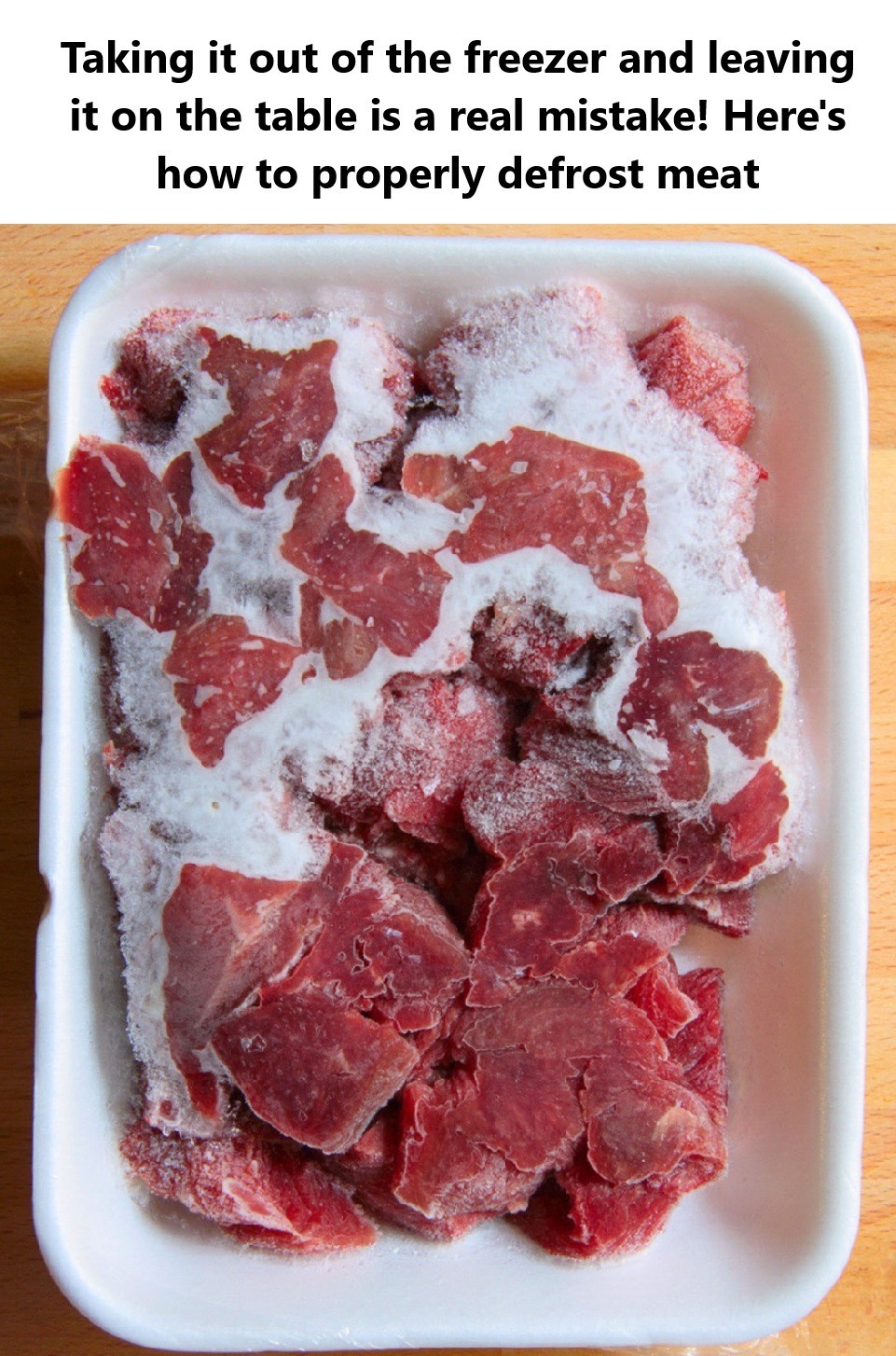ADVERTISEMENT
How to Do It:
- Step 1: Remove the frozen meat from its packaging (if needed) and place it on a plate or in a shallow pan to catch any moisture or liquid that may leak out.
- Step 2: Place the meat in the refrigerator, preferably on the bottom shelf to prevent any drips from contaminating other foods.
- Step 3: Thawing times will vary depending on the type and size of the meat. Smaller cuts like chicken breasts or pork chops may take 6-8 hours, while larger items like whole chickens or roasts can take 24 hours or more.
Pros:
- Safe: Keeps meat at a safe temperature (below 40°F), reducing the risk of bacterial growth.
- Quality: Preserves the texture and flavor of the meat.
Cons:
- Time: This method takes the longest, so plan ahead and allow plenty of time for thawing.
2. Cold Water Method (Fast, but Requires Attention)
If you’re in a pinch and don’t have 24 hours to wait, the cold water method is a much faster way to defrost meat safely. By using cold water, you can thaw your meat in just a few hours, but you need to stay on top of the process to ensure it’s done properly.
How to Do It:
- Step 1: Place the meat in a leak-proof plastic bag. This will prevent water from seeping in and affecting the texture or introducing bacteria.
- Step 2: Submerge the sealed bag in a bowl or sink full of cold water. Make sure the water is cold to avoid the growth of bacteria.
- Step 3: Change the water every 30 minutes to ensure it stays cold. Smaller cuts of meat (like steaks or chicken breasts) may thaw in 1-2 hours, while larger cuts (like a roast or a whole chicken) can take 3-4 hours.
- Step 4: Cook the meat immediately after it has thawed using this method.
Pros:
- Fast: Thaws meat much faster than the refrigerator method.
- Safe: Keeps the meat in a safe temperature zone by using cold water and changing it regularly.
Cons:
- Attention Required: You need to monitor and change the water frequently.
- Immediate Cooking: Meat thawed by the cold water method should be cooked immediately after defrosting to ensure food safety.
3. Microwave Method (Quick but Can Affect Quality)
The microwave method is the fastest way to defrost meat if you’re truly short on time. However, it can partially cook the meat, which may impact its texture and flavor. It’s best used for smaller cuts of meat or when you plan to cook the meat immediately after defrosting.
How to Do It:
- Step 1: Remove the meat from any packaging and place it on a microwave-safe plate.
- Step 2: Use the microwave’s defrost setting based on the weight of the meat. If your microwave doesn’t have a defrost function, set the power to 30% and check the meat every 1-2 minutes.
- Step 3: Rotate or flip the meat halfway through the process to ensure even thawing.
- Step 4: Once the meat is thawed, cook it immediately to avoid any bacterial growth.
Pros:
- Super Fast: This is the fastest method for defrosting meat, making it perfect if you’re in a time crunch.
- Convenient: Great for small cuts or individual servings.
Cons:
- Uneven Thawing: Microwaves often thaw meat unevenly, which can lead to partially cooked edges and a less-than-ideal texture.
- Texture Loss: Thawing meat too quickly in the microwave can cause it to lose moisture and become tougher when cooked.
4. Cooking from Frozen (When You Don’t Have Time to Thaw)
If you forget to defrost your meat or simply don’t have time, you can cook it from frozen! It may take a bit longer, but it’s a safe and effective way to make sure your meal still happens.
How to Do It:
- Step 1: Preheat your oven, stovetop, or slow cooker as usual.
- Step 2: Season the frozen meat as desired and cook it directly from the freezer.
- Step 3: Adjust the cooking time as needed. You’ll likely need to add 50% more cooking time when cooking meat from frozen, depending on the size and type of the meat.
Pros:
- Convenient: You don’t need to worry about thawing at all.
- Safe: Cooking from frozen is safe as long as the meat reaches the appropriate internal temperature.
Cons:
- Longer Cooking Time: It will take longer to cook from frozen, so plan accordingly.
Common Mistakes to Avoid When Defrosting Meat
- Thawing on the Countertop: Leaving meat out at room temperature for too long can cause bacteria to grow rapidly, which is a food safety hazard. Always thaw meat in the refrigerator, cold water, or microwave, not at room temperature.
- Refreezing Thawed Meat: Once meat has thawed, avoid refreezing it unless it’s been cooked first. Refreezing meat that was previously thawed can affect its texture and quality.
- Defrosting Meat in Hot Water: Using hot water can cause the outside of the meat to warm up too quickly, leading to uneven thawing and potential bacterial growth. Always use cold water when using this method.
Conclusion
Defrosting meat doesn’t have to be a stressful process, even when you’re short on time. Whether you use the refrigerator method for safe, slow thawing, the cold water method for faster results, or the microwave method when you’re in a real rush, knowing the correct way to thaw meat will ensure it cooks safely and tastes great.
Always plan ahead when possible, but remember, if you’re in a time crunch, there are still quick and safe ways to get your meat thawed and ready for cooking. Keep these methods in mind, and you’ll be able to enjoy your favorite meals without the worry of improperly thawed meat!
ADVERTISEMENT
